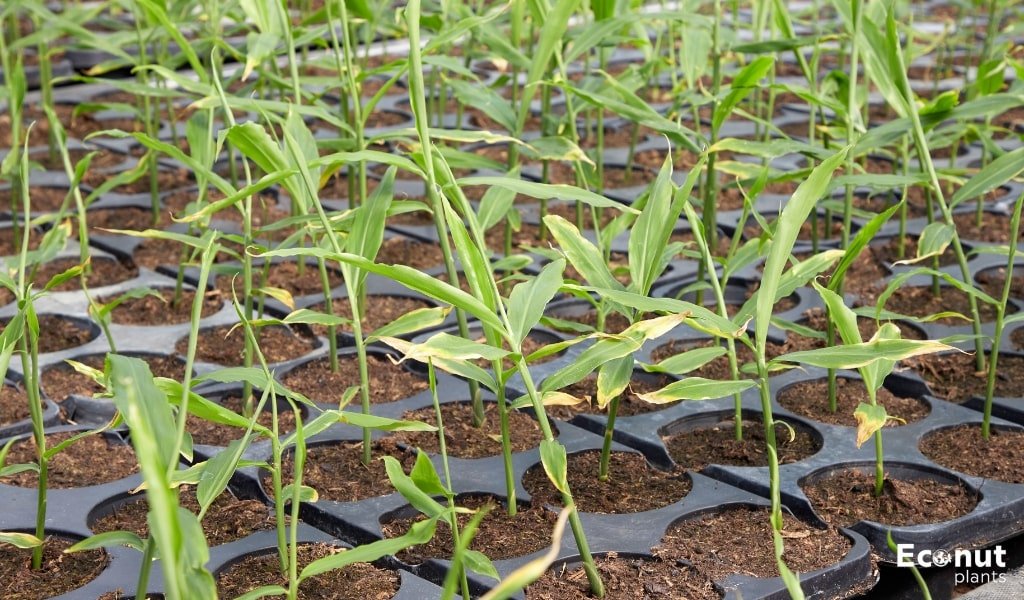Ginger, or Zingier officinal, is a flavourful spice that is extensively used in a variety of international cuisines. This is a tasty rhizome that can be grown in even the tiniest gardening space by home gardeners.
This season, are you interested in growing ginger plants in pots or other containers? This beautiful herb does well in a variety of container gardening setups. Here are some excellent container gardening suggestions for gorgeous ginger plants!
Choose the Right Container
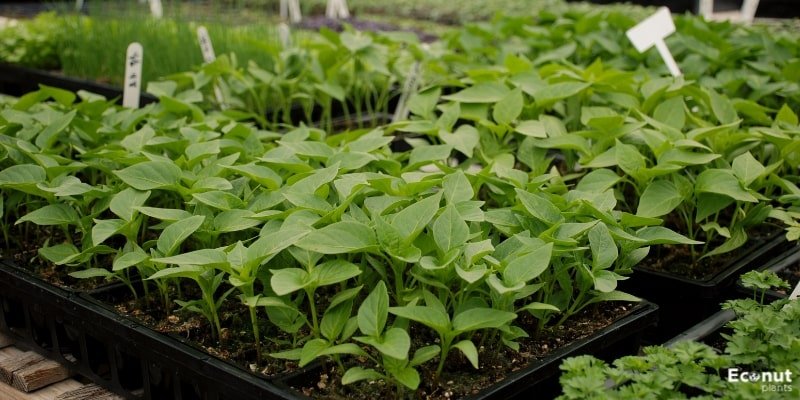
It’s harder than you might imagine to choose a container. It seems logical that a deeper pot would give a plant more room to develop if it were being grown for its rhizomes. Rhizomes are not roots, though.
Whereas ginger rhizomes develop horizontally, carrots require deep growth since they are roots. Instead of a deeper pot, they need a wider one.
Aim for 8 to 12 inches of depth. This allows the roots and rhizomes adequate room to spread out and descend to the proper depth. To maximize your crop, choose a container that is wider than deep. This will let your rhizomes spread out and multiply more.
Select the Right Variety
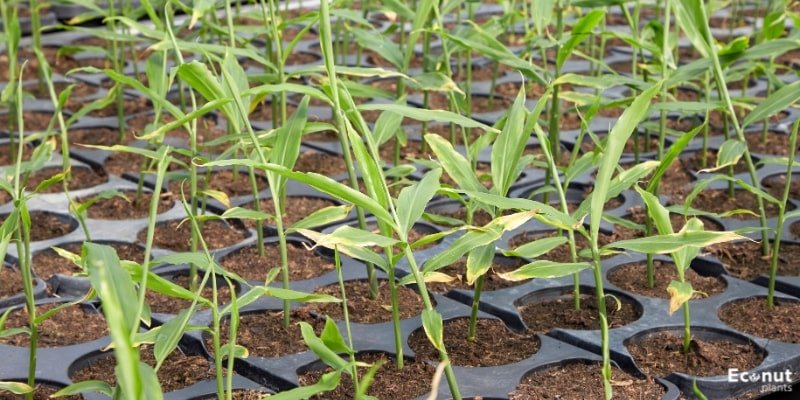
The Zingiberaceae family of plants includes more than 1,300 species. Some of these plants are grown only for decorative purposes, whereas others are not edible. In cookery, about fourteen species are commonly employed. Common ginger, shell ginger, butterfly ginger, and cardamom ginger are the best varieties for cooking.
Stores carry turmeric, another plant in the Zingiberaceae family that has its culinary applications. Using the same growing guidelines as ginger, turmeric may also be grown in pots.
Prep Your Rhizomes Properly
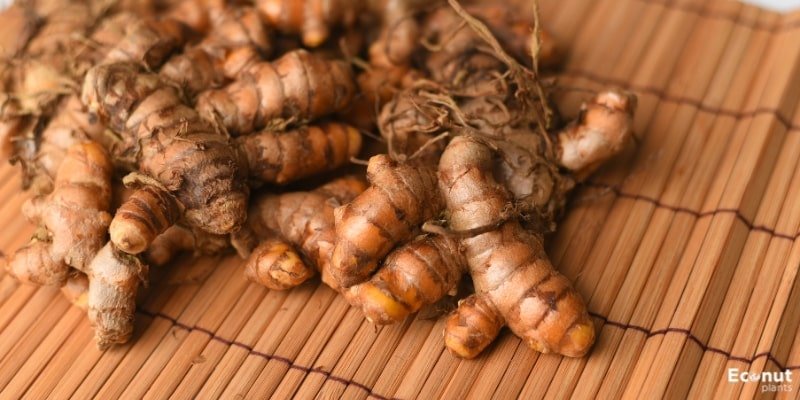
When it comes to getting ginger ready for planting, there are three main ways of thinking. You’ll learn more about that later on when we discuss proliferation following harvesting. Rhizomes can be directly sown into the ground or a container in one of two ways: either soak them overnight to help promote development or let the ends heal on their own.
Plants can grow more quickly if they are submerged in water to shed their outer layer. Even in the absence of a growth inhibitor, soaking rhizomes will promote development if they are left untreated. This helps shield ginger from root rot because it is a plant that loves water.
Choose the Right Potting Mix
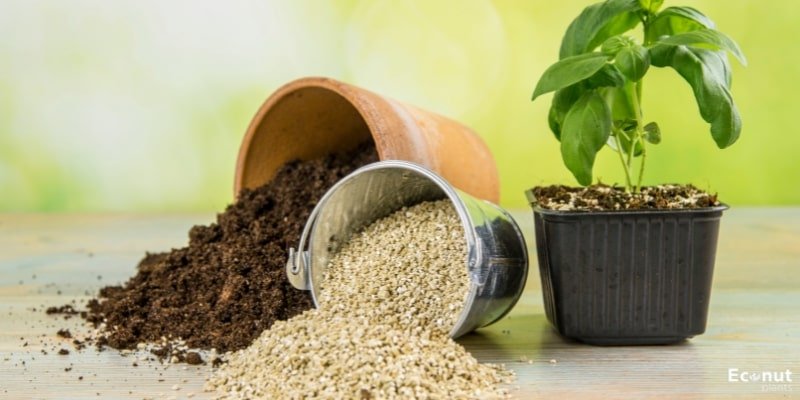
Soils with a high organic content and a mild pH are ideal for growing ginger. Avoid soil that compacts readily if you want the rhizomes to develop as freely as possible. It should have loose, well-draining soil.
Raised bed soil or regular potting mix should both function nicely. To help your rhizomes get a healthy start and create a more nutrient-rich foundation, feel free to incorporate some compost, worm castings, or manure.
Place your Rhizomes Carefully
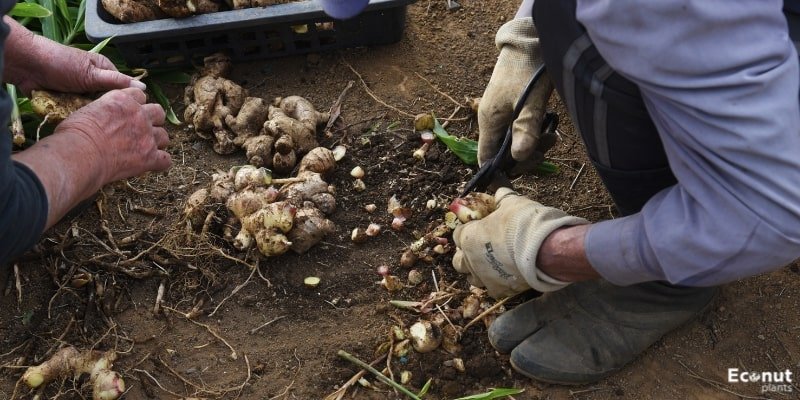
Ginger does not require deep planting, in contrast to root crops. The most crucial thing to remember is to plant the rhizome with its tips or eyes pointing upward.
Planting them face-up implies less labour for the plant because these are the areas where the rhizome will send up leaves. Your rhizomes will develop and multiply more quickly the sooner those leaves receive sunshine.
More than an inch of earth covering your rhizomes is not necessary. Given its preference for wetness, water ginger as soon as you plant it to help it take root.
Choose the Right Location
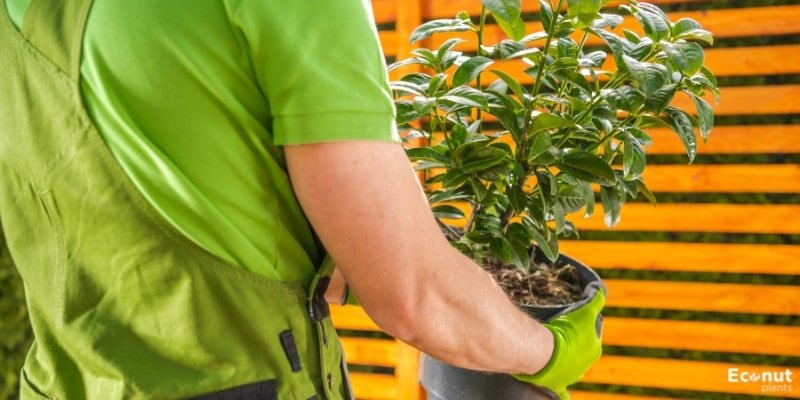
Gingers are plants that prefer moderate sun. When the plant receives plenty of early sunlight without being directly exposed to the strong afternoon sun, the lighting conditions are ideal.
If you plan to store your potted ginger indoors, pick a spot with plenty of sunlight. Indoor plants are capable of withstanding sunlight for the majority of the day.
When cultivating outside, avoid direct sunlight and afternoon shadows. If, after planting, you find that the leaves appear wilted even though the plant is getting enough water, it could be the afternoon light.
Water Regularly
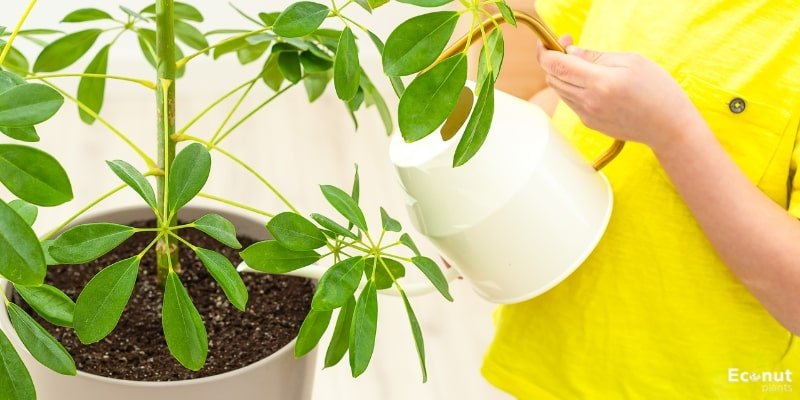
Since ginger is a rhizomatic plant, it prefers moisture; yet, excessive moisture can cause root rot. A. W. As detrimental as overwatering might be, make sure your growing medium has easy access to excess water drainage. Ginger also loves the humidity.
It requires significantly more humidity—between 70 and 90 percent—to survive indoors than most people find comfortable. You can increase the humidity in the space around your ginger plants by using a humidifier or pebble tray. A bright bathroom is another great place to put plants in containers.
Keep it Toasty

Keep in mind that, being a tropical plant, ginger cannot withstand the winter months. Low temperatures—below fifty degrees—will be detrimental to plants. Because it loves warm weather and heavy humidity, ginger is best kept outside during the summer.
It is intolerant of temperatures below fifty degrees, therefore, during the cooler months, you should keep it indoors unless you live in zones 11–12, where temperatures seldom go below that range.
Move the plant outside when the weather warms. Choose a location that receives filtered sunlight or shade in the morning and afternoon. Bring plants inside once more in the autumn as the weather starts to drop. It takes eight or 10 months for plants to mature.
Fertilize
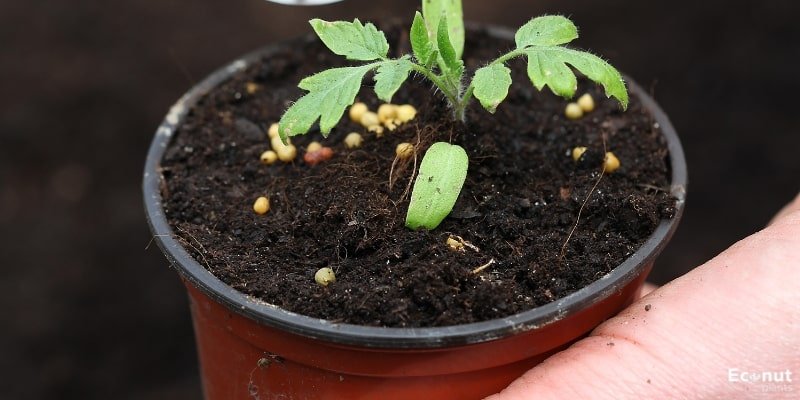
Since ginger is a strong feeder, fertilizer is essential to producing an abundant crop. In this case, a balanced 1-3-1 NPK mixture is often abundant since it prevents excessive nitrogen boosts and overgrowth of foliage. The intended outcome, increased rhizome development, can be achieved with a lower nitrogen fertilizer.
Apply diluted liquid organic fertilizer as soon as the first shoots poke through the ground, then fertilize again every two to three weeks while the plant is growing. After applying an organic granular fertilizer, mix it into the soil first, then wait for the recommended amount of time on the container, since these fertilizers release nutrients only after they break down.
Cow and poultry manure that has been properly composted makes excellent fertilizers as well since it releases nutrients gradually over an extended period. They do not require frequent administration and can be mixed into the original soil blend before planting.
Look Out For Insects
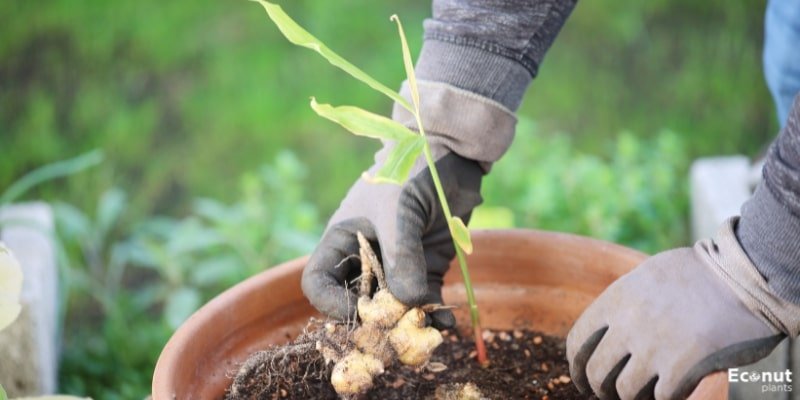
Given their sweet sap and aromatic blossoms, ginger trees are a favourite food source for a variety of insects. Neem oil works well as a safe remedy for minor pest infestations.
Indelicidal soaps and horticultural oils are good options for more serious infestations. These pesticides are hazardous to beneficial and pollinating insects, so if your plants are blooming outside, stay away from using them.
Monitoring your plants can help prevent infections before they cause significant harm. Examine any newly purchased indoor plants before exposing them to the environment, as most pests enter homes through infected plants.
Give it Time
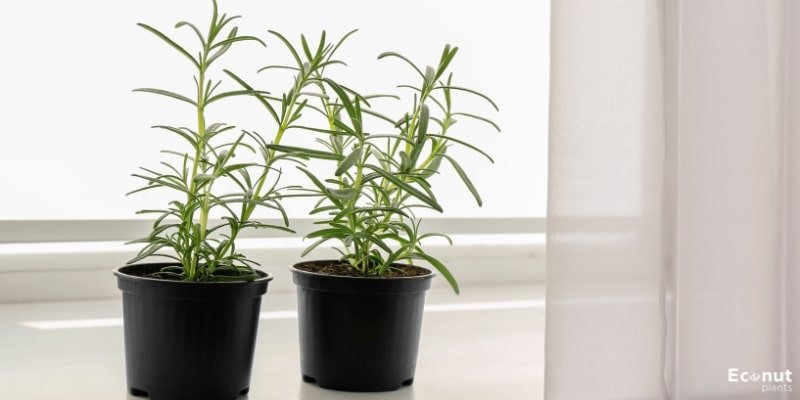
Ginger is a slow-growing plant. You should plan on waiting 8–10 months to harvest for cooking purposes. If you are growing it for ornamental purposes, be patient with your plants and let those rhizomes mature, as it can take up to 3 years to produce blossoms.
Harvest at the Right Time
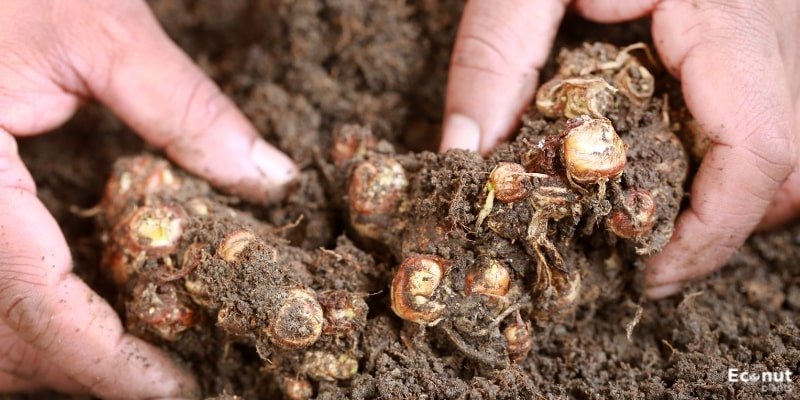
Ginger plants take eight to 10 months to mature. To get the most out of your crop, it is best to wait until they have finished growing.
When you notice this change in the stems, around two or three weeks before you plan to gather the rhizomes, trim off everything that is slightly above the soil’s surface. Before harvesting, let the earth completely dry.
Cut off the remaining stems after carefully removing the rhizomes. Select the number of plants you wish to cultivate the following season and save some rhizome cuttings for future plantings. Seek out areas that are fat and have tiny growth buds.
Preserve Your Excess Ginger
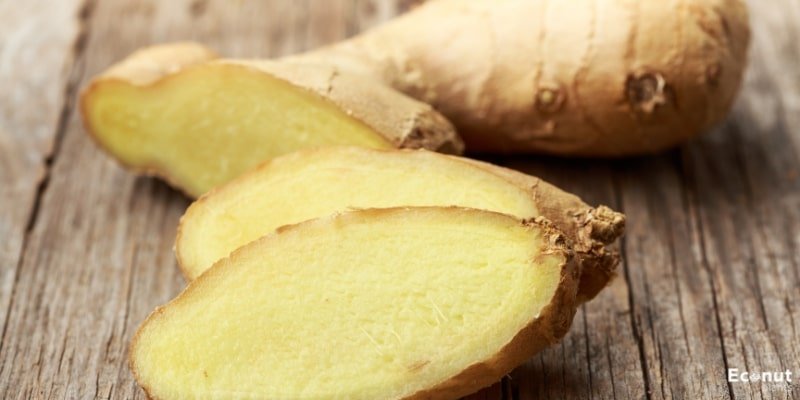
That peeling will all be done in two or three weeks. For more on preserving ginger, I should write a follow-up article.
You can do as you choose with the remaining portion of the year. If left frozen for at least five months, it freezes quite nicely. Before freezing, peel the roots and store them whole in an airtight jar. Additionally, for convenience of use, the roots can be grated and preserved.
Making ginger powder by drying and grinding the roots is an excellent alternative method of storing ginger. However, ground ginger loses flavour more quickly than the other methods, so use your ground ginger within a year for the best flavour.
Propagate When Appropriate
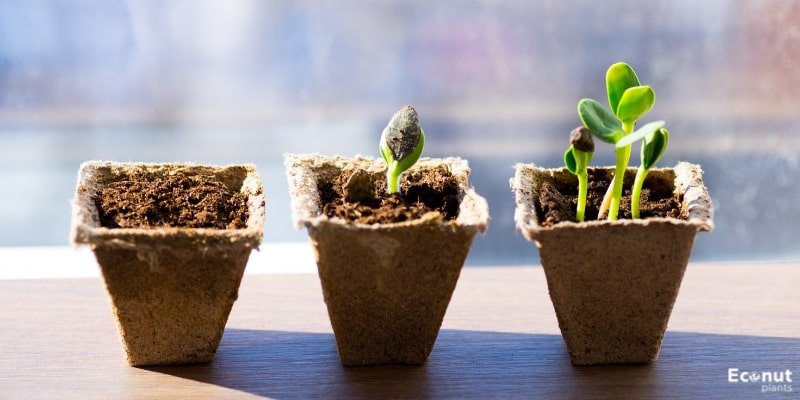
Once you’ve successfully developed your ginger plant, don’t forget to reproduce it! There are three equally effective ways to do this, two of which are slightly faster than the others.
- Propagate in water: Ginger grows quite well when planted in water. All you have to do is submerge a section of the rhizome in water and watch the roots spread.
- Direct sowing: Directly sowing your rhizomes back into the container is the final technique, which we have already discussed. This is slower than the other approaches, but it is just as effective. It is less complicated and labour-intensive, though.
- Paper towel method: An alternative method is to wrap the rhizomes in paper towels and store them in a resalable bag to keep them moist. Additionally, roots will form as a result of this process; these roots can be planted when they are one to two inches long.
Conclusion
Growing ginger in pots is a good way to cultivate it for culinary or decorative uses. When the weather gets too cold, those in colder climates should think about putting their ginger in containers because they can quickly bring it indoors. Harvesting ginger rhizomes is more convenient and easier when they are grown in pots.

